
It is a common misconception that the reason the Dreamcast failed was because it could play copied games… Well, that wasn’t entirely true.
The point of this article is to explain that you can’t simply copy the contents of a Dreamcast GD-ROM to a CD-R and expect it to boot on an unmodified retail Dreamcast.
There is copy protection in place to prevent this. The reason you can play burned games is because the ISO files you find online have been modified to take advantage of the MIL-CD exploit. Unlike games, MIL-CDs have no copy protection so the Dreamcast will boot them without questioning authenticity.
The idea of this post was to de-bunk the myth that the Dreamcast had no security in place to keep people from copying games and playing them. Meanwhile, it had one of the most sophisticated forms of copy protection… With just one little oversight.
Also, for games that didn’t fit onto a CD-R, they would rip out or downsample some of the content (usually FMV’s or background music).
The dreamcast actually used GD-ROM discs that only developers had access to writing such discs in a manufacturing setting.
It was an incredibly involved process to turn a GD-ROM game into a bootable CD-R. But already made CD-R games were easy to copy.
The GD-ROM fit about 1gb of data and only a small portion of the disc such as a certain audio track to tell you that you can’t play in a cd player was there.
While many games actually had less than 700mb size, a few titles had more than 700mb size.
The 700mb or less size games can fit on a standard cd and be formatted into MIL-CD so the dreamcast can play it.
